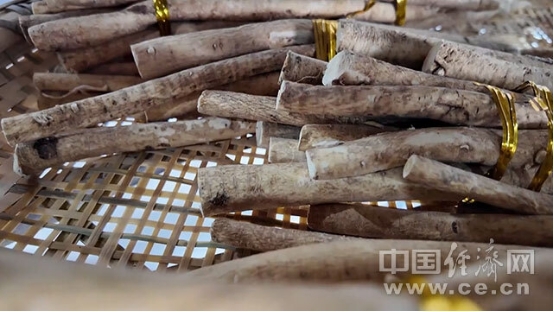By Chen Jiaqi, Han Lu

(Photo by Zhang Peng)
GUYANG, Aug 5(China Economic Net) - In the quiet county of Guyang, nestled at the foot of the Yin Mountains in Inner Mongolia, a small but mighty plant is rewriting the story of rural revitalization. This is the home of Mongolian astragalus—a traditional medicinal root with over a thousand years of cultivation history and a growing reputation for its healing properties.
Located at the latitude of 41° North, Guyang boasts an ideal climate for growing astragalus. But the plant's significance here goes far beyond its medicinal value. It’s now at the heart of a thriving local economy that has emerged from decades of hardship and innovation.
Just 20 years ago, astragalus farmers in Guyang were struggling. After months of backbreaking labor, they often had no buyers for their harvest. Some even ended up burning the root as firewood—its market value too low to justify the work it took to grow it. Without processing infrastructure, branding, or quality certification, even the best astragalus from Guyang couldn’t break into premium markets.
That’s no longer the case.
Today, Guyang is home to a fully integrated astragalus industry. At modern agricultural parks, the entire value chain is now in place—from quality testing and R&D to processing, storage, logistics, and product distribution. Astragalus is no longer just a dry root in a sack; it has become the raw material for over 200 products across seven different categories, including pharmaceuticals, wines, skincare, food, teas, wellness supplements, and even aromatic products. Every part of the plant is used, from root to leaf, unlocking its full economic value.
The growth is measurable. By 2025, the county’s astragalus cultivation area will exceed 16,800 acres, including a large certified organic base. And it’s not just about scale—it’s about quality. Lab tests from 2024 revealed that Guyang-grown astragalus contains 0.194% astragaloside IV, more than double the national pharmacopoeia standard. Another key compound, calycosin-7-glucoside, also tests at high levels, confirming Guyang’s natural advantage and careful cultivation practices.
Inside modern facilities like those operated by Jun Kang Qiye, the transformation of astragalus is as precise as it is innovative. Roots are soaked for eight hours, then carefully extracted over five more to produce a concentrated raw essence ten times stronger than the original. Every step is digitally monitored, with real-time data flashing across large control screens—a striking fusion of ancient tradition and modern science. And beyond the lab, new astragalus-based products are continuously launched, from cookies and shampoos to facial masks, giving this old-world remedy a fresh face in the consumer market.
The economic impact on the region is significant. One company alone, Lühui Bio, requires 500 tons of astragalus annually, creating steady income for over 800 farming households and generating nearly $4 million in annual revenue. Another local firm, Longju Agriculture, has developed a popular astragalus-infused wine, also reaching the $4 million mark in 2024 and helping raise farmers’ incomes by as much as 30%.
Back on the land, quieter but equally important innovations are taking root. Local agricultural expert Hao Junmao and his team at the county's agricultural tech center have been experimenting with high-ridge planting techniques, which improve soil aeration and promote stronger root growth. The result is a more potent, higher-value plant. Hao is optimistic: with these new methods, even farmers with no prior experience will soon be able to grow top-grade astragalus with confidence.
What was once a neglected herb with no market and no future is now a pillar of prosperity for an entire region. This transformation didn’t happen overnight. It took decades of scientific investment, strategic coordination, and the hard work of thousands of farmers. But today, the astragalus plant—grown in the mountain-shadowed fields of Guyang—is no longer just a traditional medicine. It’s a symbol of how innovation, dedication, and the right conditions can turn even the humblest of crops into a pathway toward a brighter future.
(Editor: fubo )


